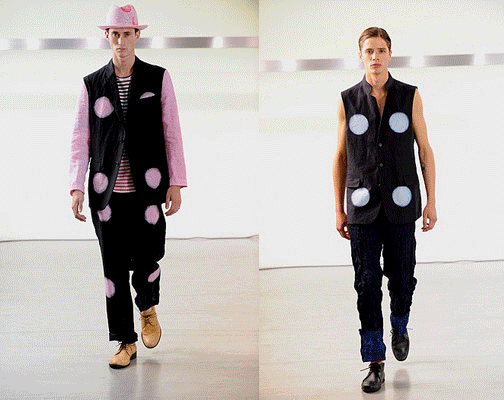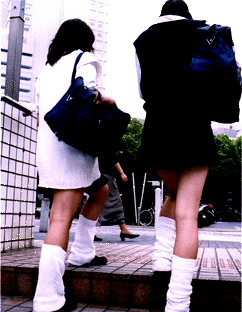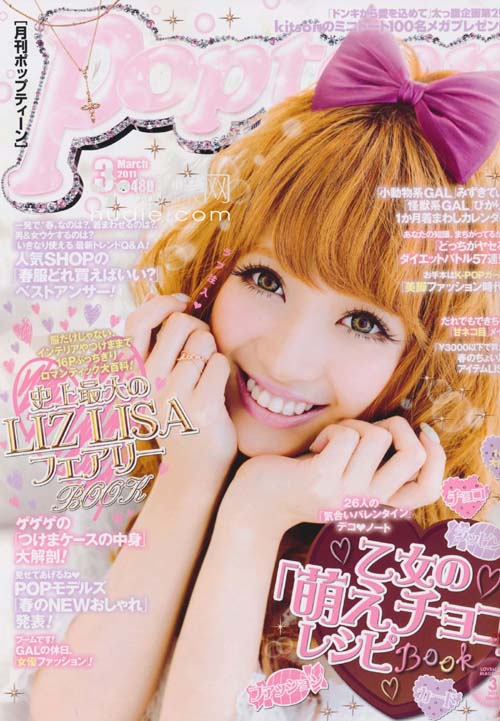 Fashion is the means of expressing identity. Dressing is a ritualistic, symbolic, everyday practice that we use to situate ourselves in the chaotic, judgmental world around us. The simple act of putting on a piece of clothing immediately conveys one’s position of cultural power, class distinction, gender, and subculture, all while participating in the global economy. Deciding what we wear matters, especially in an urban, capitalist society where fashion is a tool to distinguish ourselves from one another. On an international scale, the fashion industry represents an interesting view of understanding national power and identity [3].
Fashion is the means of expressing identity. Dressing is a ritualistic, symbolic, everyday practice that we use to situate ourselves in the chaotic, judgmental world around us. The simple act of putting on a piece of clothing immediately conveys one’s position of cultural power, class distinction, gender, and subculture, all while participating in the global economy. Deciding what we wear matters, especially in an urban, capitalist society where fashion is a tool to distinguish ourselves from one another. On an international scale, the fashion industry represents an interesting view of understanding national power and identity [3].
Professional Designers Dare to be Different
The early 1980s marked an explosion of Japanese fashion in the global industry. The fashion world reacted strongly to the avant-garde, radically different ideas of the country’s designers. The new garments articulated different ideas of what fashion was and the relationship of clothes and body. Japan gradually became a genuine force of change, challenging tradition and introducing new artistic contradictions [3].
In order to stand out from mainstream fashion and fabricate an “essence of Japaneseness,” [3] The densely populous nature of Japan naturally creates a desire for differentiation [1], and the “consumption of a cultural good (clothing) performs an increasingly important role on the construction of personal identity [2].” Native Japanese designers work to challenge convention. Amanda Mayer Stinchecum, a historian specializing in the cloth and clothing of Ryukyu, Okinawa, and mainland Japan said, “[These designers] make us realize that the designs we take for granted are merely conventions that fashion has been following and reinterpreting for the last 50 years. The Japanese have stepped outside these conventions and made something new, something of their own.” And it is the fact that these designers are questioning fashion that allows them to work against what is accepted and invent their own, new genre of clothing beyond the boundaries of nationality. “I hoped to create a new universal clothing which is challenging to our time,” stated famous fashion designer Issey Miyake [3].
A Japanese Identity
Creating a separate identity is very important for Japan. Japanese fashion designers have to work hard to combat Orientalism and European cultural hegemony that dominates what is culturally and aesthetically acceptable in the fashion realm. Power and standards of beauty are directly related. An article in Vogue featured a spread on Japanese fashion designers of the 1980s as major fashion influences, but used war rhetoric when labeling the images as the “Japanese invasion.” Japan can’t escape its view as oriental, as a country compared to the mighty fashion standards of Europe and America. Kondo writes:
“An editor with American Elle told me that many French fashion people are fascinated with Japan, for they consider Japan to be the only country truly to appreciate and to understand French fashion on an aesthetic level… the utterance reasserts the centrality of French fashion as a standard. The air of authority with which pronouncements of Western superiority are made gives eloquent testimony to the battles for recognition in which the Japanese designers work in what they consider to be a postmodern, transnational space, persistent tropes of nation and culture push them back into an essentialized Japanese identity.”[3]
Post-Bubble Effect on Teens
The reason why Japan is struggling to find an identity for the nation and its people is due to the burst of the economic bubble in the late 1990s. A mass feeling of disillusionment wafted over the country. The sudden recession and inflation after such a prosperous economic period led to a different lifestyle for the Japanese youth. Traditional family, social, and economic systems have gradually become weaker. The Japanese value system, especially that of teens, changed. Since 1998, teens between 14 and 19 have been involved in 50% of all felony arrests, including murder [2]. Many twenty-somethings continue to live at home due to high real-estate prices. Living rent-free, these young adults can spend their money on clothing, making them the largest consumer demographic. The shopping districts of Japan are swarmed with young people, with hardly a sign of anyone over thirty. Curator Koji Yoshida explains that the “phenomenon of the free-spending Japanese youth is a product of paternal guilt. After the bubble burst, fathers lost their rights and respect. They had to appease their children by giving them lots of gifts and money.” Under these social and economic conditions, teens became increasingly creative and innovative to try and create their new, individual post-bubble identity. Just like Japanese fashion designers, they wanted to grab attention, break traditional rules, and challenge and redefine the existing notion of what is fashionable and aesthetic [4].
In order to feel accepted, teens wanted to share an affiliation through fashion, communicating and bonding through clothing, while remaining an individual. The result is the rise of Japanese street fashion. A social network of various street subculture identities, each with their original look, gives Japanese teens the edge and identity they crave, visually symbolized in their fashion persona. Completely guided by teens, “street fashion in the fashionable districts of Tokyo, such as Harajuku and Shibuya, is independent of any mainstream fashion system and goes beyond the conventional model of fashion business with different marketing strategies and occupational categories [2].”
In 1993, one of the first trends was to wear long, baggy white socks bunched up at the ankle like legwarmers amongst high school girls in Tokyo. By 1996, the trend was so popular that if you weren’t wearing them, it was embarrassing. As many as 35 different types of loose socks were sold in stores, and it is still acceptable to wear them today in suburbs and small towns. The fashion industry leapt on the opportunity to take advantage of the marketing potential of teens and their rebellion against mainstream fashion [2].
Teens as Trendsetters, Consumers, Icons, and Designers of Street Fashion
Over the past 10 years, a separate system of fashion with a new business model has been created in Japan in order to commercialize street fashion and post the market. Girls have become the driving force for the street fashion scene. They spend much of their time and money on clothes and makeup because it is a way for them to stand out and get noticed, also a way of rebelling against tradition. Urban schoolgirls championed the start of street fashion in the mid-1990s, and today much of the fashion economy is centered around the opinions and wallets of teenage girls [2].
The holy land of street fashion resides in the Shibuya district at a place called the Shibuya 109 (pronounced as Shibuya Ichi-Maru-Kyu) Department Store. More than 100 hip and inexpensive stores on 10 levels supply the Japanese teenagers with the newest fashions. Here at Shibuya 109 also lies the holy grail of street fashion: the salesgirl position. Surprisingly the most coveted job in the street fashion industry, salesgirls are an integral part to buying and selling the merchandise, as well as designing for the store labels, so becoming a salesgirl is extremely coveted and competitive. The salesgirls have first-hand knowledge of the kind of tastes the teens have and what garments and accessories they are looking for because of their direct day-to-day contact with the teen customers. “The salesgirls themselves become icons, known as karisuma tenin, literally translated as charismatic salesgirls.” When the popular street fashion magazine, Popteen, surveyed 500 Shibuya teens for who their fashion role models were, there were no celebrities ranked in the top five. Among the icons listed were amateur high school models that appeared in street fashion magazines and salesgirls in the 109 Department Store [2].
The idea of a teen consumer as a designer goes against our Western fashion industry, where trends are set by companies for us consumers to follow and purchase. The teens’ voices are valued over professional designers’ visions when it comes to street fashion. Teens dictate what they want and then it is produced. Just like the ADD nature of teenagers, Japanese street fashion is constantly changing, trends spread like wildfire, and all of a sudden everyone is wearing it [2]. Because of the fast-moving trend cycles, scarcity becomes a key ingredient to street fashion culture. Only a few copies of each garment or accessory are produced, making them expensive and in high demand. Shifts of teenagers wait in lines outside stores, where twenty or so at a time are let through the doors to rush in, scour the shelves, and leave only for another wave of frantic teens to come in. Hours are spent waiting in line, but this becomes a fun activity for Japanese teens to do with their friends [4].
The obvious differences and outlandishness of Japanese fashion to the Western eye can be more easily understood when explained in terms of the fervent search for a unique, modern Japanese identity. Japan’s urge to revive itself from its economic crash, and long-lasting cultural devastation from WWII, comes in its attempts for a fresh, futuristic take on culture, technology, and social norms. With fashion as a strong visual representation of Japan’s youth culture’s changing attitudes, we can see Japan’s future being challenged and morphed by this creative and eccentric generation.
Discussion Questions:
- Is a high-priced, fast-paced fashion market driven by teens a sustainable economic practice for post-bubble Japan?
- Beauty is simply defined differently by the Japanese, and they are continually pushing the boundaries. Do you see a place for the Japanese outlandish aesthetic in mainstream fashion? Are we just witnessing the beginnings of the future of fashion?
- The word otaku means being focused and almost obsessed with something you like. Otaku originally referred to a category of young Japanese men who were fixated on manga. The word is now used to describe someone with a fanatical interest in computers or fashion. In a frantic search for an individual identity, what is the significance of teens’ obsession with fashion?
- What are the differences between the fashion produced by high fashion designers, like Issey Miyake, and street fashion “designers”?
Related Links
“Freaky Fashion Trends” of Japan
Sources
- Fernie, John, and Nobukazu Azuma. “The changing nature of Japanese fashion, Can quick response improve supply chain efficiency?.” Emerald Journal of Marketing 38.7 (2004): 790-804. Web. 18 Mar 2011. <http://www.emeraldinsight.com/journals.htm?articleid=853944>.
- Kawamura, Yuniya. “Japanese Teens as Producers of Street Fashion.” Current Sociology 54.5 (2006): 784-801. Web. 18 Mar 2011. <http://csi.sagepub.com/content/54/5/784.full.pdf+html>.
- Kondo, Dorinne. “The Aesthetics and Politics of Japanese Identity in the Fashion Industry.” Re-made in Japan, Everyday life and the consumer taste in a changing society. Ed. Joseph J. Tobin. New Haven/London: Yale University Press, 1992. Print.
- Mead, Rebecca. “Letter from Tokyo: Shopping Rebellion.” New Yorker 18 Mar 2002: n. pag. Web. 20 Mar 2011. <http://www.newyorker.com/archive/2002/03/18/020318fa_FACT?currentPage=1>.




Awesome article, Tori! I didn’t know much about Japanese fashion, but somehow the styles seem rather familiar and unsurprising. I like the thought of the teenagers trying to find their identity through what they wear, and yet following the newest fad regardless; it’s very much like what happens in America. I’m also fascinated by this veneration of shop girls. I assume the stores know of the pull of their employees, which makes me wonder what kind of specialty hiring standards they might use to keep control of this power.
Speaking of America, though, what do you think are the major differences between teen-based stores and shopping in Japan and here? Is there any chance of a Claire’s, for example, ever becoming a cultural icon in America the way Shibuya 109 is in Japan? Also, what’s your take on more constant niche styles, like Ganguro or Hime Gyaru, which are worn consistently by admittedly small subsections of the population? Are they, too, examples of the Japanese identity or is theirs a more individualistic search?
On the “Video of Japanese Shop Girls” website, under the video there’s a link that says “Read More >>” If you click that it will give you a pretty good translation of the main points of each section of the video. If you have a question about a specific section, let me know, and I’ll do my best to explain it more.
thank you for sharing valuable and informative content with us
topaz-jewelry
thanks for giving valuable information to us, Thank you so much
sofa-cum-bed